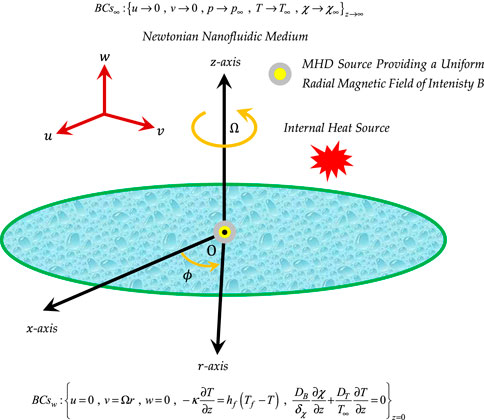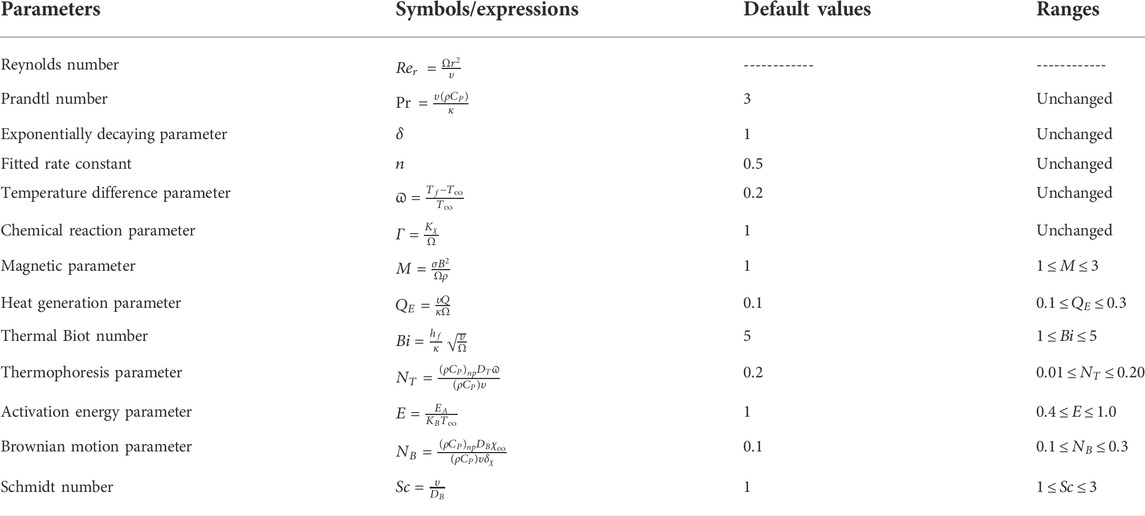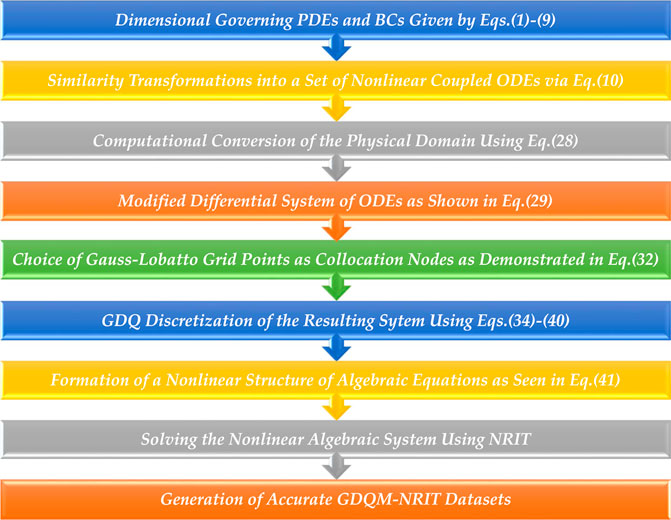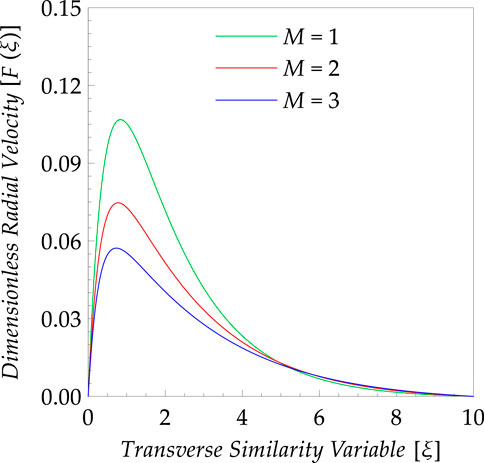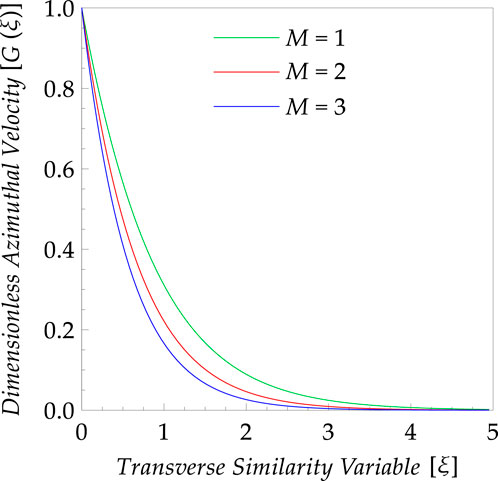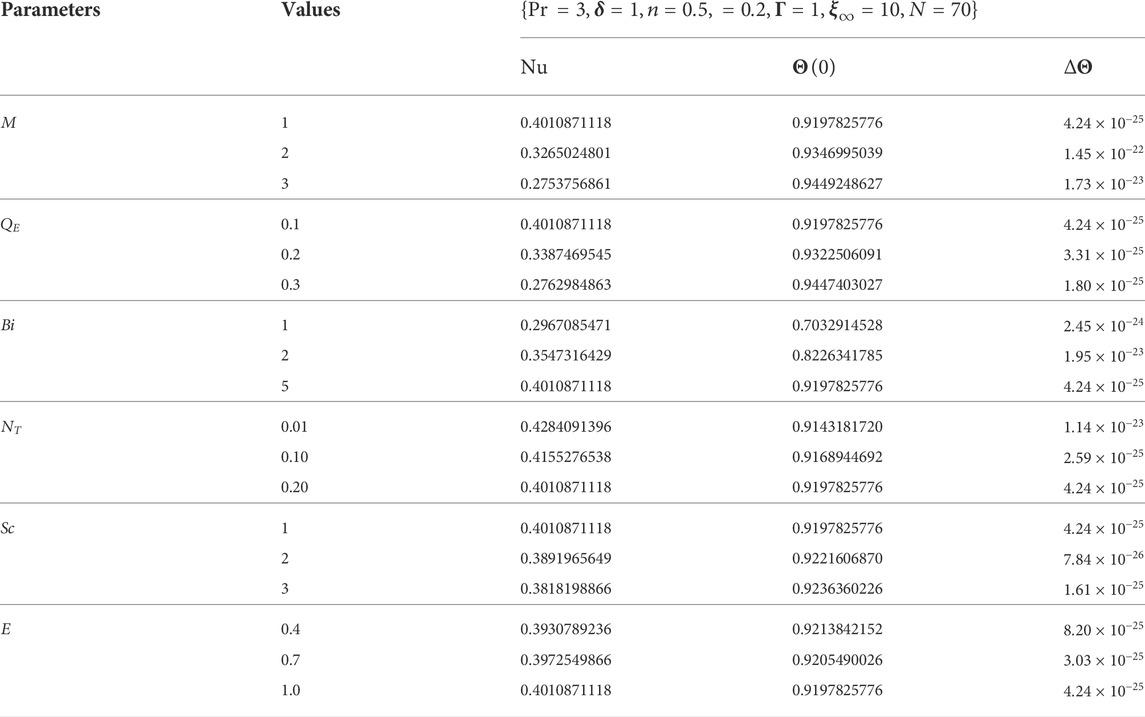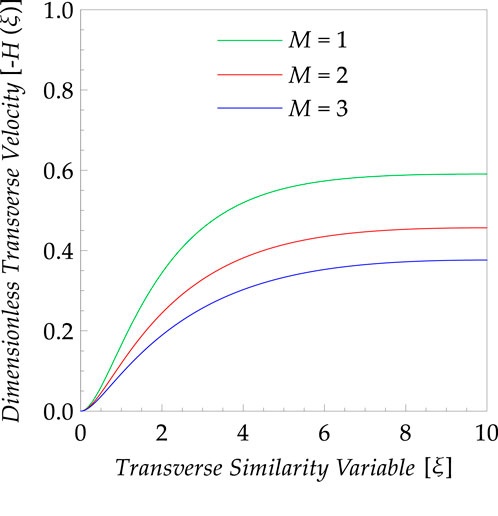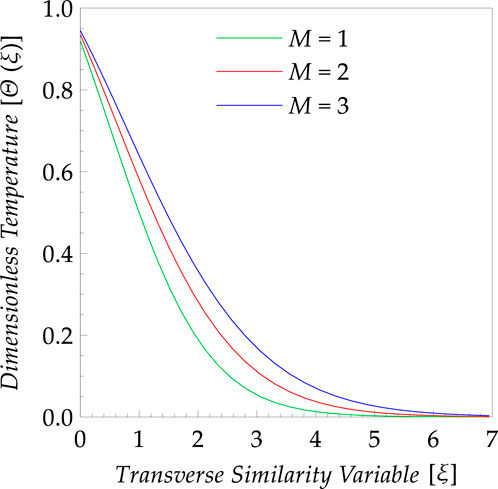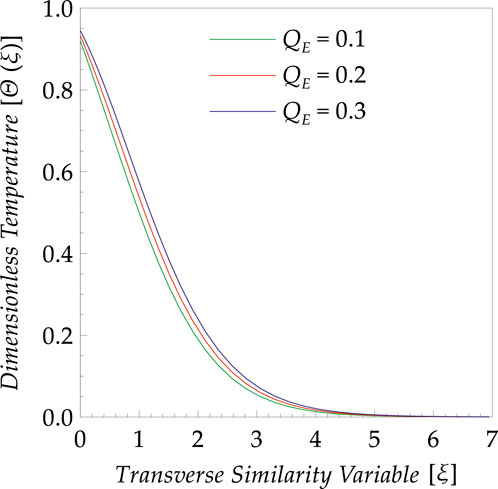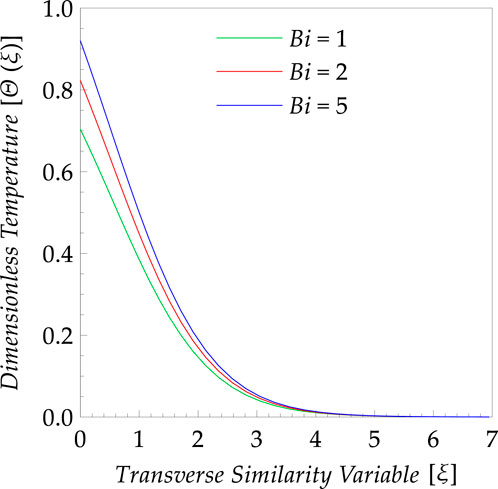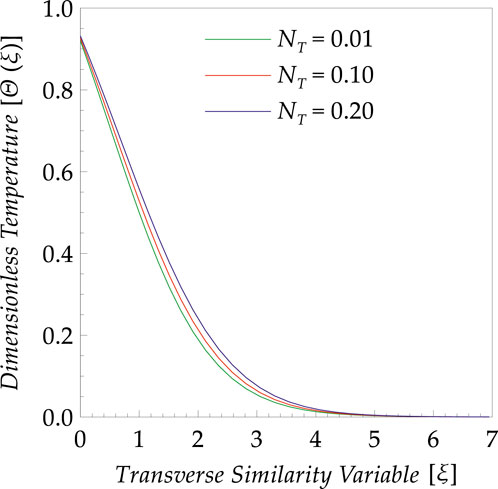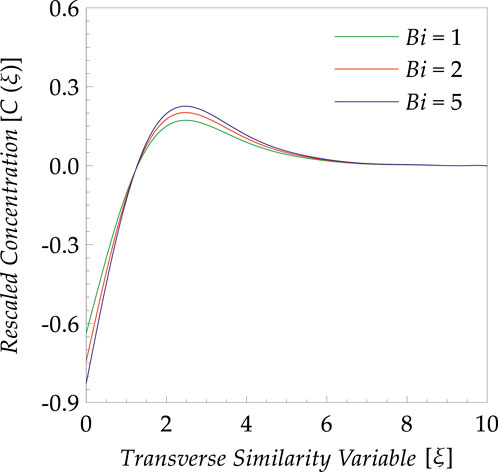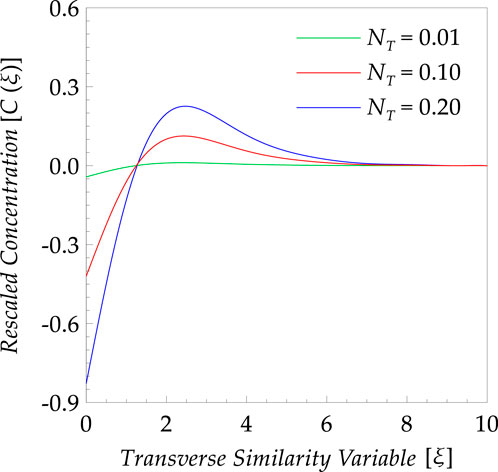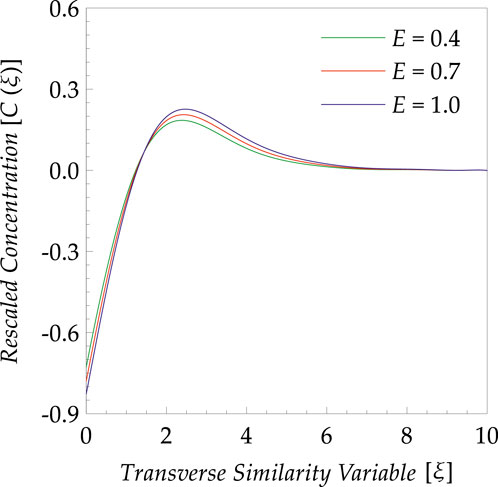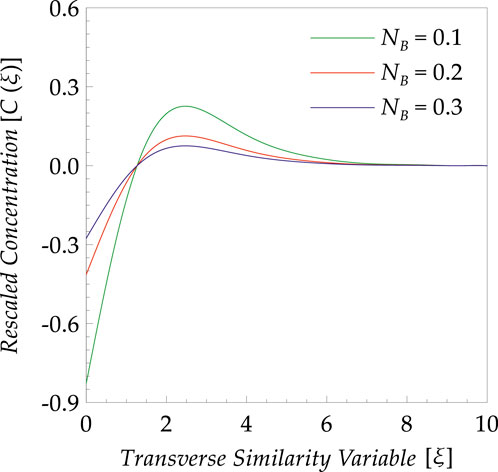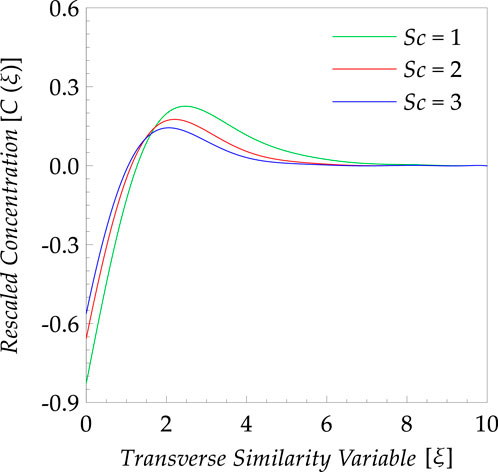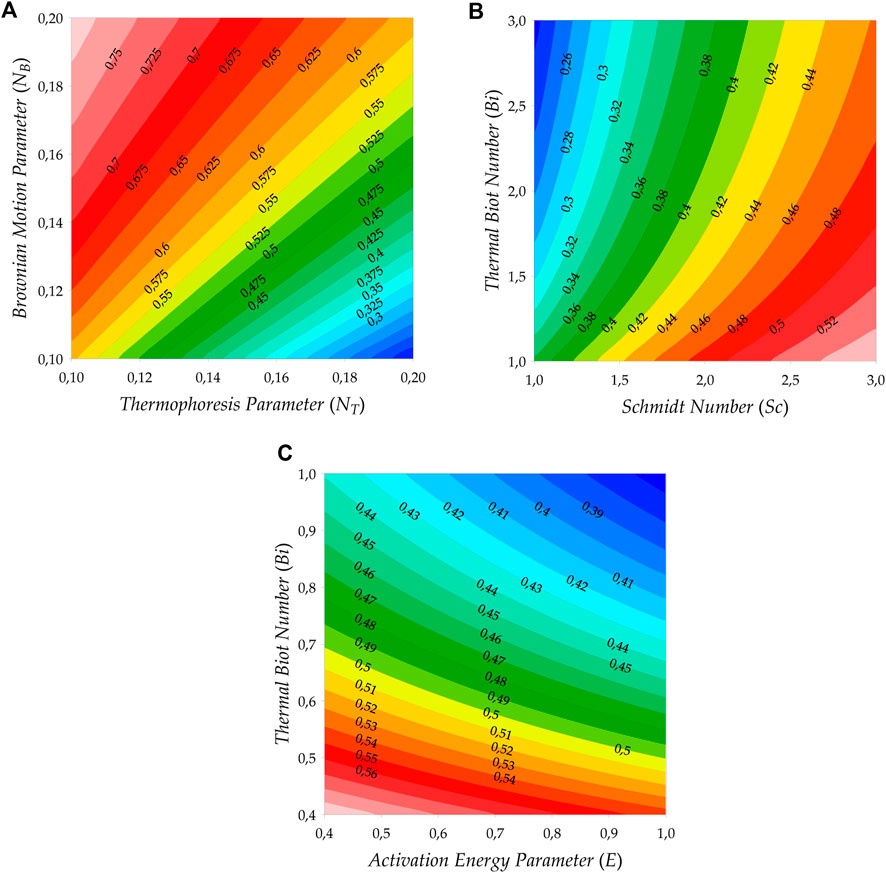- 1Laboratory of Mechanics, Faculty of Sciences Aïn Chock, Hassan II University of Casablanca, Casablanca, Morocco
- 2LPQ3M, Université Mustapha Stambouli de Mascara, Mascara, Algeria
- 3Mechanical Engineering Department, College of Engineering and Islamic Architecture, Umm Al-Qura University, Makkah, Saudi Arabia
- 4College of Computer Science, King Khalid University, Abha, Saudi Arabia
- 5Electronics and Micro-Electronics Laboratory (E. μ. E. L), Faculty of Sciences of Monastir, University of Monastir, Monastir, Tunisia
- 6Geo-Informatics and Space Technology Development Agency (GISTDA), Chonburi, Thailand
- 7Geo-Informatics and Space Technology Development Agency (GISTDA), Bangkok, Thailand
- 8Department of Mathematics, Faculty of Science, Phuket Rajabhat University (PKRU), Phuket, Thailand
Owing to the various physical aspects of nanofluids as thermally enhanced working fluids and the significance of swirling flows in rheological devices as well as in the spin coating and lubrication applications, the current comprehensive examination aimed to explore the important features of spinning flows of chemically reactive Newtonian nanofluids over a uniformly revolving disk in the existence of a radially applied magnetic field along with an exponentially decaying space-dependent heat source, in the case where the disk surface is heated convectively and unaffected by the vertical nanoparticles’ mass flux. Based on feasible boundary layer approximations and Buongiorno’s nanofluid formulation, the leading coupled differential equations are stated properly in the sense of Arrhenius’s and Von Kármán’s approaches. By employing an advanced generalized differential quadrature algorithm, the obtained boundary layer equations are handled numerically with a higher order of accuracy to generate adequate graphical and tabular illustrations for the different values of the influencing flow parameters. As findings, the graphical results confirm that the nanofluid motion decelerates meaningfully thanks to the resistive magnetic influence. A significant thermal amelioration can be achieved by strengthening the magnetic impact, the generation of heat, the thermal convective process, and the thermophoresis mechanism. Moreover, it is found that the thermo-migration of nanoparticles can be reinforced more via the intensification in the convective process, the thermo-migration of nanoparticles, and the activation energy.
1 Introduction
During the last decades, the topic of heat/mass enhancement through multi-phase flows (e.g., monotype/hybrid/ternary nanofluid flows) has attracted amazing consideration from the scientific communities around the globe owing to their widespread necessity in several practical domains (e.g., the ameliorating the combustion characteristics of diesel fuel in compression ignition engines). In this context, it was demonstrated through a benchmark experimental investigation [1] and other authenticated sources [2, 3] that regular liquids (e.g., oil, ethylene glycol, and water) are not preferred thermally as working fluids due to their weak thermal conductance. As technical propositions, it was advised that the insertion of tiny/nano-sized particles (e.g., alumina, graphene, copper oxide, gold, titania, silver, copper, as well as single- and multi-walled carbon nanotubes) is among the best feasible way for improving the thermal performances of pure fluids on the condition that the adding solid nanoparticles should have a higher thermal conductivity as compared with the host fluid. Such a biphasic mixture (i.e., nanoparticles and base fluid) was named a nanofluid for the first time in 1995 by Choi and Eastman [4]. Thanks to the latest progress in the mixture theory and the science therein, the existing experimental and theoretical literature surveys involve an exhaustive overview regarding the principal specific appearances describing persuasively the physical, thermal, and rheological aspects of nanofluids [5–10]. In this respect, it was reported that the thermophysical proprieties of nanofluids depend on several influential factors (e.g., shape/size of nanoparticles as well as their concentration and temperature) that can affect significantly the heat transfer within a nanofluidic medium and its flow pattern. By linking theoretically the bioconvection occurrence phenomenon to other thermal and mass transport processes, Waqas et al. [11] proposed advanced non-homogeneous flow models constrained by realistic physical impacts to explore the consequence of swimming motile microorganisms on the hydrothermal and mass features of slippery nanofluid flows near a variable thick surface of a rotating disk. More recently, Shah et al. [12] exploited the possibility of hybridizing the nanoparticles
Convective flows over rotating heated disk-shaped bodies are considered among the main popular dynamical problems treated fundamentally in fluid mechanics and heat transfer since a long time ago. Further, the dealing of flows near rotating disks is of great interest to the majority of researchers not only for comprehending the occurring flow regimes but also for their diverse uses (e.g., stability control of swirling flows, domestic devices, rotating heat exchangers, visco-rheometers, chemical stirring operations, spinning disk reactors, vehicle engines, and productive aero-hydrodynamic turbines). In this respect, several examinations were accomplished roughly for such flow problems [15–17]. In 1921, Von Kármán [18] was the first pioneering scientist who discussed theoretically the dynamical axisymmetric aspect of steady swirling flows driven over a rotating infinite disk for incompressible viscous fluids. Based on the boundary layer theory, Navier-Stokes’s mathematical formulation of this famous fluid flow problem can be extended reasonably to the case of non-Newtonian fluids [19, 20] (e.g., Bingham and tangent hyperbolic fluid models). Mathematically, the simplified boundary layer equations can be reduced to a nonlinear system of coupled ordinary differential equations, whose similar solutions can be derived semi-analytically or numerically through the modified so-called Von Kármán’s integral momentum equation. Keeping in mind the rheological and thermal importance of nanofluids and their applicabilities in Von Kármán’s flow configuration, several scrutinizations were performed recently on nanofluid flows over a rotating disk. In this context, Waini et al. [21] performed a numerical stability analysis of unsteady axisymmetric swirling flows of
Nonetheless, inclusive studies on the significant impacts of Arrhenius’s chemical reactive kinetics, the thermo-migration diffusive process, and the Brownian motion of nanoparticles on MHD Von Kármán non-homogeneous flows of chemically reacting nanofluids over a horizontal turning disk are still rare in the available literature, in the case of zero mass flux and thermal convective conditions, and especially when the electrically conducting nanofluidic medium is exposed to an adjustable magnetic source acting radially, which is enhanced thermally via an exponentially decaying space-dependent heat source. Motivated by this pending scientific concern, the present examination aimed surely to provide definitive answers on this open topic. Accordingly, an appropriate MHD nanofluid flow model has been developed properly in this regard by adopting the renovated version of Buongiorno’s approach. Based on the generalized boundary layer simplifications and other admissible physical assumptions, the leading conservation equations are derived mathematically in the form of coupled partial differential equations (PDEs) together with their corresponding realistic boundary conditions (BCs), which are rewritten thereafter as a set of strongly nonlinear ordinary differential equations (ODEs) having no closed-form solutions. For this reason, an advanced hybrid algorithm has been implemented numerically in Matlab software. After performing extensive validating tests, the generated datasets are presented skillfully to provide a comprehensive physical discussion through the following research questions:
1- How can formulate a proper MHD non-homogeneous Von Kármán flow model for a chemically reactive nanofluid by considering the effective contribution of Brownian and thermophoresis diffusions and utilizing the molar concentration notion, in the case where the external magnetic field is exerted radially in the presence of an exponentially decaying heat generation?
2- How can associate the generalized differential quadrature algorithm with Newton-Raphson’s technique in a methodological solution to evidence the present three-dimensional MHD convective nanofluid motion and determine the temperature and nanoparticles’ molar concentration distributions?
3- What are the advantages of using GDQM- NRIT as a hybrid numerical approach?
4- When and to what computational level we can consider that the outputted results are numerically admissible?
5- What are the dynamical and thermal impacts of the applied external magnetic field?
6- Which control parameters can exhibit an enhancing thermal trend?
7- How can determine the unknown wall characteristics related to the nanoparticles’ molar concentration and the temperature by exploiting the conditions of zero mass flux and convective heating?
8- What are the mass influences of convective heating and Arrhenius’s chemical reaction on the Brownian and thermophoretic migrations of nanoparticles?
2 Governing equations and physical model
Let’s consider a steady laminar nanofluid flow over an impermeable disk of infinite extension, which is rotated uniformly around its symmetrical
− The viscous nanofluid has a Newtinanan rheological trend and behaves as a weakly electrically conducting medium, in which the induced magnetic field can be ignored in front of the externally applied magnetic field.
− Since the strength of the applied magnetic field is not strong enough, the physical influence of Hall’s current can be neglected obviously.
− In addition to the convective heating process and the existence of solid nanoparticles within the viscous nanofluidic medium, the occurred boundary layer regions are due also to the uniform rotation of the geometrical configuration.
− The momentum, thermal, and concentration boundary layer approximations are adopted along with the renewed Buongiorno’s model to formulate the proposed nanofluid flow model.
− The governing PDEs of thermal energy and nanoparticles’ distribution are adjusted appropriately by utilizing the molar concentration of nanoparticles
− The contribution of Brownian motion and thermophoresis mechanism are incorporated effectively in the proposed nanofluid flow model by invoking the two-phase nanofluid model.
− The base fluid is in local thermal equilibrium with the solid nanomaterials.
Based on the above statements, the leading conservation PDEs are written as:
These conservation equations are governed by the following BCs:
For the sake of briefness, the meanings of the physical symbols and abbreviations used above are well regrouped in the nomenclature table. Further, it is preferable to introduce feasible similarity alterations into Eqs. 1–9 as suggested below:
Accordingly, the following ODEs and BCs are yielded:
For more clarification on the influencing parameters involved in Eqs. 13–17, a technical list of the pertinent flow parameters is provided properly as seen in Table 1.
Fundamentally, the total viscous frictional coefficient
Besides, the wall shear stress components
By injecting the transformations of Eq. 10 into Eqs. 19–23, we get the reduced forms :
As underlined above, the reduced quantities
Before starting the numerical modeling of the present nanofluid flow problem, the spatial physical domain
By focussing only on the physical function
Also, Eq. 24 and 25 are altered to:
3 Numerical solution methodology
Numerically, the precise approximate solutions satisfying the nonlinear coupled differential system of Eq. 29 can be developed easily via an advanced hybrid algorithm GDQM-NRIT, which is principally based on the generalized differential quadrature method (GDQM) and Newton-Raphson’s iterative technique (NRIT). For this purpose, a non-uniform distribution of spatial collocation nodes
where
In the framework of the proposed numerical procedure, the following generalized differential quadrature approximations are invoked during the
in which
Computationally, the mathematical algorithm of the weighing GDQ coefficients
Accordingly, we obtain the following nonlinear algebraic system:
An efficient NRIT algorithm has been developed properly to generate accurate discrete solutions
Briefly, the most important strategic steps involved in the suggested methodological solution are outlined in Figure 2.
Once the computed SREs reach very low values, the following dimensionless physical quantities can be deduced accurately:
4 Multiple validations of generalized differential quadrature method-Newton-Raphson’s iterative technique results
A perfect authentication of the executed GDQM-NRIT code has been demonstrated evidently in Table 2 for the quantities
5 Results and discussion
This illustrative section is dedicated especially to the physical deliberations of MHD Von Kármán’s flow that can be happened suddenly within a chemically reactive nanofluidic medium in the presence of an internal heat generation. In this respect, several physical aspects have been explored for this kind of axisymmetric flow under the significant impact of a radial magnetic source. To strengthen the onset of heat and mass transport phenomena within the nanofluidic medium, a chemical reaction mechanism is taken place destructively according to Arrhenius’s kinetics and the thermal aid of an exponentially decaying space-dependent heat generation source, in the case where the disk surface is heated convectively and unaffected by the vertical nanoparticles’ mass flux. Based on the generated GDQM-NRIT outputs, numerous dimensionless demonstrations are portrayed properly for the radial, azimuthal, and transverse velocity fields
The unified dynamical influence of the magnetic parameter
Keeping in mind the hindering mechanical demeanor of Lorentz’s forces towards the nanofluid motion, an amount of thermal energy is communicated substantially. For this reason, the temperature profile
In the framework of the passive control approach, the vertical nanoparticles’ mass flux becomes zero at the surface disk due to its impermeability characteristic. In this case, Sherwood’s number gets vanished as long as there is no mass transfer manifestation to evaluate quantitatively for the solid nanoparticles at the horizontal boundary. This physical situation leads to a top-heavy configuration, in which the solid nanoparticles will regroup more nearby the cold region as revealed in Figures 10–14 for the nanoparticles’ molar concentration distribution
From an engineering point of view, the behaviors of the reduced quantities
6 Concluding remarks
Among the main derived remarks, we can write:
• The proposed numerical algorithm shows a higher degree of flexibility during the computational handling of the present nanofluid flow problem, in which the GDQM-NRIT results can be provided accurately with a low computational cost.
• A postponing effect is seen for the magnetic parameter towards the nanofluid motion in all directions.
• An elevation in the temperature profile can be achieved via the greater values of the magnetic parameter, the heat generation parameter, the thermal Biot number, and the thermophoresis parameter.
• A significant strengthening in the thermo-migration of nanoparticles can be obtained via the grander magnitudes of the thermal Biot number, the thermophoresis parameter, and the activation energy parameter.
• The downward motion of nanoparticles can be reinforced considerably via the increasing values of the Brownian motion parameter and the Schmidt number.
• The surface drag force factor can be reduced by weakening the magnetic parameter.
• The magnitude of the temperature gradient can be ameliorated significantly at the wall via the growing values of the activation energy parameter and thermal Biot number.
• Compared to other control parameters, the activation energy parameter
Data availability statement
The original contributions presented in the study are included in the article/supplementary material, further inquiries can be directed to the corresponding author.
Author contributions
Data curation; AW, AA, KG, BB, RK, PK, and AJ. Formal analysis; AW, AA, KG, BB, RK, PK, and AJ. Investigation; AW, AA, KG, BB, RK, PK, and AJ. Supervision; PK. All authors discussed the results, wrote, and commented on the manuscript at all stages. All authors have read and agreed to the published version of the manuscript.
Funding
This research was funded by the Science, Research and Innovation Promotion Fund (Grant No: 2495051). The project is funded by National Research Council of Thailand (NRCT) (Grant No: N42A650183). The authors would like to thank the Deanship of Scientific Research at Umm Al-Qura University for supporting this work by Grant Code:(22UQU4331317DSR50).
Acknowledgments
The authors extend their appreciation to the Deanship of Scientific Research at King Khalid University for funding this work through Large Groups [grant number RGP.2/208/43]. The authors would like to thank the Deanship of Scientific Research at Umm Al-Qura University for supporting this work by Grant Code:(22UQU4331317DSR50).
Conflict of interest
RK and PK are employed by Geo-Informatics and Space Technology Development Agency (GISTDA).
The remaining authors declare that the research was conducted in the absence of any commercial or financial relationships that could be construed as a potential conflict of interest
Publisher’s note
All claims expressed in this article are solely those of the authors and do not necessarily represent those of their affiliated organizations, or those of the publisher, the editors and the reviewers. Any product that may be evaluated in this article, or claim that may be made by its manufacturer, is not guaranteed or endorsed by the publisher.
References
1. Buongiorno J, Venerus DC, Prabhat N, McKrell T, Townsend J, Christianson R, et al. A benchmark study on the thermal conductivity of nanofluids. J Appl Phys (2009) 106:094312. doi:10.1063/1.3245330
2. Bergman TL, Incropera FP, Lavine AS, Dewitt DP. Introduction to heat transfer. John Wiley & Sons (2011).
3. Angayarkanni SA, Philip J. Review on thermal properties of nanofluids : Recent Developments. Adv Colloid Interf Sci. (2015) 225:146–76. doi:10.1016/j.cis.2015.08.014
4. Choi SUS, Eastman JA. In: DA Siginer, and HP Wang, editors. Enhancing conductivity of fluids with nanoparticles, Developments and applications of non-Newtonian flows, 66. New York: Am. Soc. Mech. Eng. (1995). p. 99–105.
5. Koo J, Kleinstreuer C. A new thermal conductivity model for nanofluids. J Nanopart Res (2004) 6:577–88. doi:10.1007/s11051-004-3170-5
6. Koo J, Kleinstreuer C. Viscous dissipation effects in microtubes and microchannels. Int J Heat Mass Transf (2004) 47:3159–69. doi:10.1016/j.ijheatmasstransfer.2004.02.017
7. Koo J, Kleinstreuer C. Laminar nanofluid flow in microheat-sinks. Int J Heat Mass Transf (2005) 48:2652–61. doi:10.1016/j.ijheatmasstransfer.2005.01.029
8. Koo J, Kleinstreuer C. Impact analysis of nanoparticle motion mechanisms on the thermal conductivity of nanofluids. Int Commun Heat Mass Transfer (2005) 32:1111–8. doi:10.1016/j.icheatmasstransfer.2005.05.014
9. Li J. Computational analysis of nanofluid flow in micro-channels with applications to micro-heat sinks and bio-MEMS. Ph.D. Thesis. Raleigh, NC, the United States, Raleigh, NC, United States: NC State University (2008).
10. Corcione M. Empirical correlating equations for predicting the effective thermal conductivity and dynamic viscosity of nanofluids. Energy Convers Manag (2011) 52:789–93. doi:10.1016/j.enconman.2010.06.072
11. Waqas H, Yasmin S, Althobaiti N, Bonyah E, Alshehri A, Shah Z. Evaluating the higher-order slip consequence in bioconvection nanofluid flow configured by a variable thick surface of disk. J Nanomater (2022) 2022:1–13. doi:10.1155/2022/2766317
12. Shah Z, Ullah A, Musa A, Vrinceanu N, Ferrandiz Bou S, Iqbal S, et al. Entropy optimization and thermal behavior of a porous system with considering hybrid nanofluid. Front Phys (2022) 10:1–15. doi:10.3389/fphy.2022.929463
13. Maneengam A, Bouzennada T, Aissa A, Guedri K, Weera W, Younis O, et al. Numerical study of lid-driven hybrid nanofluid flow in a corrugated porous cavity in the presence of magnetic field. Nanomaterials (2022) 12:2390–17. doi:10.3390/nano12142390
14. Alshare A, Aissa A, Guedri K, Younis O, Fayz-Al-Asad M, Ali HM, et al. Hydrothermal and entropy investigation of nanofluid natural convection in a lid-driven cavity concentric with an elliptical cavity with a wavy boundary heated from below. Nanomaterials (2022) 12:1392–17. doi:10.3390/nano12091392
15. Liu C, Pan M, Zheng L, Ming C, Zhang X. Flow and heat transfer of Bingham plastic fluid over a rotating disk with variable thickness. Z Für Naturforsch. A. (2016) 71:1003–15. doi:10.1515/zna-2016-0218
16. Hussain Z. Unsteady MHD flow due to eccentric rotations of a porous disk and an oscillating fluid at infinity. ZAMM - J Appl Math Mech/Z Angew Mathematik Mechanik (2021) 101:e202000369. doi:10.1002/zamm.202000369
17. Rández X, Zaversky F, Astrain D. A novel active volumetric rotating disks solar receiver for concentrated solar power generation. Appl Therm Eng (2022) 206:118114. doi:10.1016/j.applthermaleng.2022.118114
18. Von Kármán T. Uber laminare und turbulente Reibung. Z Angew Math Mech (1921) 1:233–52. Von Kármán. doi:10.1002/zamm.19210010401
19. Ahmadpour A, Sadeghy K. Swirling flow of Bingham fluids above a rotating disk: An exact solution. J Nonnewton Fluid Mech (2013) 197:41–7. doi:10.1016/j.jnnfm.2013.03.001
20. Khan U., Khan W, Badruddin IA, Ghaffari A, Ali HM. Heat transfer in steady slip flow of tangent hyperbolic fluid over the lubricated surface of a stretchable rotatory disk. Case Stud Therm Eng (2021) 24:100825. doi:10.1016/j.csite.2020.100825
21. Waini I, Ishak A, Pop I. Multiple solutions of the unsteady hybrid nanofluid flow over a rotating disk with stability analysis. Eur J Mech - B/Fluids (2022) 94:121–7. doi:10.1016/j.euromechflu.2022.02.011
22. Kumar M, Mondal PK. Irreversibility analysis of hybrid nanofluid flow over a rotating disk: Effect of thermal radiation and magnetic field. Colloids Surf A: Physicochemical Eng Aspects (2022) 635:128077. doi:10.1016/j.colsurfa.2021.128077
23. Mandal S, Shit GC. Entropy analysis on unsteady MHD biviscosity nanofluid flow with convective heat transfer in a permeable radiative stretchable rotating disk. Chin J Phys (2021) 74:239–55. doi:10.1016/J.CJPH.2021.07.036
24. Magodora M, Mondal H, Motsa S, Sibanda P. Numerical studies on gold-water nanofluid flow with activation energy Past A rotating disk. Int J Appl Comput Math (2022) 8:41. doi:10.1007/s40819-022-01241-4
25. Buongiorno J. Convective transport in nanofluids. J Heat Transfer (2006) 128:240–50. doi:10.1115/1.2150834
26. Latiff NA, Uddin MJ, Ismail AIM. Stefan blowing effect on bioconvective flow of nanofluid over a solid rotating stretchable disk. Propulsion Power Res (2016) 5:267–78. doi:10.1016/j.jppr.2016.11.002
27. Turkyilmazoglu M. Flow and heat over a rotating disk subject to a uniform horizontal magnetic field. Z Für Naturforsch. A. January (2022) 77:329–37. doi:10.1515/zna-2021-0350
Nomenclature
Greek symbols
Abbreviations
ESAT Exponential series approximation technique
GFET Galerkin finite element technique
GDQ Generalized differential quadrature
GDQM Generalized differential quadrature method
MHD Magnetohydrodynamics
NRIT Newton-Raphson iterative technique
ODEs Ordinary differential equations
PDEs Partial differential equations
RKFM Runge-Kutta-Fehlberg method
ST Shooting technique
SREs Square residual errors
Subscripts
Superscripts
Keywords: enhanced swirling nanofluid flow, non-homogeneous model, radial magnetic field, arrhenius kinetics, zero mass flux condition
Citation: Wakif A, Abderrahmane A, Guedri K, Bouallegue B, Kaewthongrach R, Kaewmesri P and Jirawattanapanit A (2022) Importance of exponentially falling variability in heat generation on chemically reactive von kármán nanofluid flows subjected to a radial magnetic field and controlled locally by zero mass flux and convective heating conditions: A differential quadrature analysis. Front. Phys. 10:988275. doi: 10.3389/fphy.2022.988275
Received: 07 July 2022; Accepted: 26 July 2022;
Published: 20 October 2022.
Edited by:
Muhammad Mubashir Bhatti, Shandong University of Science and Technology, ChinaReviewed by:
Abayomi Samuel Oke, Adekunle Ajasin University, NigeriaH. A. Kumara Swamy, Presidency University, India
N. Keerthi Reddy, Ulsan National Institute of Science and Technology, South Korea
Muhammad Bilal Arain, International Islamic University, Pakistan
Puneet Rana, Wenzhou University, China
Ebenezer Bonyah, University of Education, Winneba, Ghana
Copyright © 2022 Wakif, Abderrahmane, Guedri, Bouallegue, Kaewthongrach, Kaewmesri and Jirawattanapanit. This is an open-access article distributed under the terms of the Creative Commons Attribution License (CC BY). The use, distribution or reproduction in other forums is permitted, provided the original author(s) and the copyright owner(s) are credited and that the original publication in this journal is cited, in accordance with accepted academic practice. No use, distribution or reproduction is permitted which does not comply with these terms.
*Correspondence: Pramet Kaewmesri, cHJhbWV0LmthZUBnaXN0ZGEub3IudGg=
 Abderrahim Wakif
Abderrahim Wakif Aissa Abderrahmane
Aissa Abderrahmane Kamel Guedri
Kamel Guedri Belgacem Bouallegue4,5
Belgacem Bouallegue4,5 Anuwat Jirawattanapanit
Anuwat Jirawattanapanit